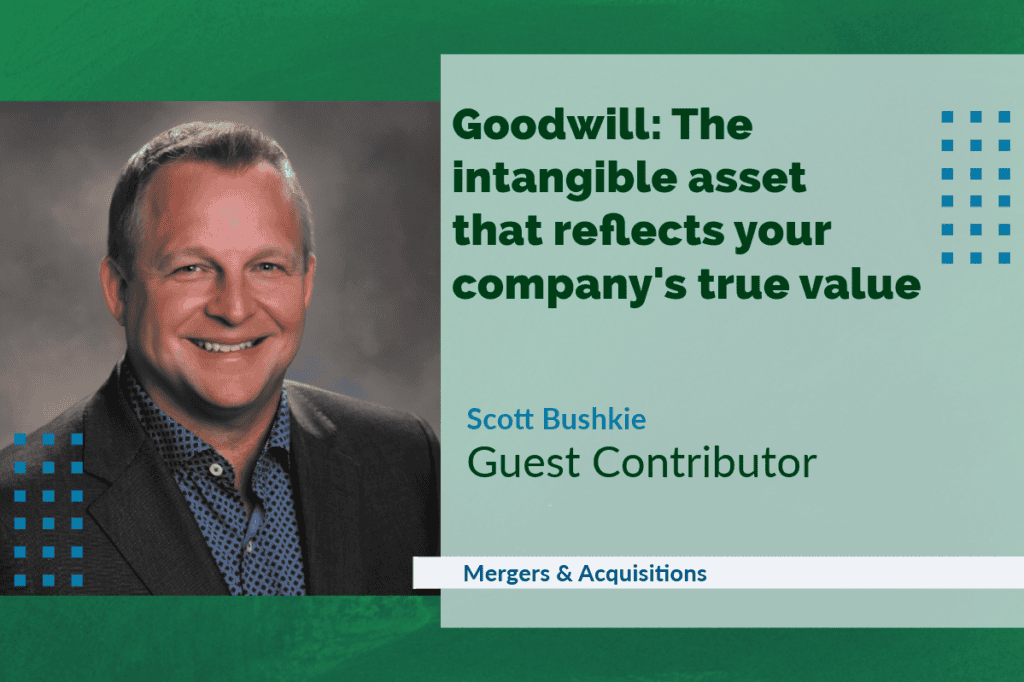
July 15, 2024
When it comes to selling a business, the term “goodwill” often arises.
But what exactly is goodwill, and how does it impact the mergers and acquisitions (M&A) process?
Goodwill is the value of a business that exceeds its tangible assets.
It arises when a company is sold for more than the worth of its physical assets, such as equipment, vehicles and inventory.
Most successful companies have some level of goodwill, which is tied to cash flow.
For example, consider a company with $2 million in EBITDA (earnings before interest, taxes, depreciation and amortization) that sells for a six multiple, resulting in a $12 million valuation.
If the company only has $5 million in physical assets, the remaining $7 million is considered goodwill.
Building goodwill
Goodwill is typically derived from the company’s ability to generate strong and consistent cash flows.
Factors, such as a loyal customer base, an effective management team, a solid market position and a unique value proposition, all contribute to a company’s ability to generate cash flows above and beyond the value of its physical assets.
Goodwill can also be attributed to factors that de-risk the company.
A strong brand, a large and diversified customer base, recurring revenue and a reliable supply chain are some of the factors that give buyers confidence they can replicate performance and drive growth in the future.
The more growth opportunities and less risk perceived by the buyer, the higher the multiple, and consequently, the more goodwill.
Financing goodwill
However, goodwill presents challenges when it comes to financing a deal.
Goodwill is an intangible asset, which means it lacks the physical substance and clear valuation of tangible assets (again, such as equipment, vehicles, or inventory).
Most traditional lenders, such as banks, often prefer to secure their loans with tangible assets that can be easily liquidated in case of default.
Moreover, the value of goodwill can fluctuate based on market conditions, industry trends and the overall financial health of the company.
If a business experiences a downturn or fails to meet its projected cash flows, the value of its goodwill may be impaired, leading to potential write-downs and negative impacts on the company’s balance sheet.
To overcome these challenges, businesses often need to explore alternative financing options or structures when dealing with significant amounts of goodwill.
Seller financing or equity rollovers can help provide funding for goodwill when traditional lenders won’t support it.
For smaller deals under $5 million, the Small Business Administration (SBA) offers loan programs providing banks with a 75% guarantee, allowing them to take on more goodwill.
For larger deals, strategic buyers with strong balance sheets, private equity groups or family offices are generally better positioned to acquire a business with significant goodwill.
These buyers can bring more equity to the table or may already have alternative acquisition lending in place, such as mezzanine lenders.
In the current deal market, most acquisitions above $10 million have a capital stack of 50% equity and 50% debt.
Using the example above, that means the buyer would bring $6 million to the table and the senior lender (e.g., the bank) would only have about $1 million in exposure above and beyond the company’s tangible assets.
That’s fairly palatable on a $12 million deal.
Allocating goodwill
When a business is sold, the purchase price is typically allocated among the various assets being acquired, including both tangible and intangible assets.
However, the allocation of goodwill can have significant (and opposing) tax implications for the buyer and the seller.
In an asset sale, the buyer and seller typically negotiate the allocation of the purchase price, considering the tax consequences for each party.
The buyer generally prefers to allocate more of the purchase price to assets that can be depreciated quickly to maximize their tax deductions.
The seller typically prefers to allocate more of the purchase price to goodwill, as it is generally taxed at a lower capital gains rate.
An indicator of success
At the end of the day, goodwill is a powerful sign of success.
However, this intangible asset can also present challenges when financing an M&A deal.
Business owners looking to sell their companies should be prepared to explore creative financing solutions and navigate negotiations around asset allocation.
Experienced M&A advisors and tax professionals can help.
 HSHS to invest $270 million in St. Mary’s, St. Vincent
HSHS to invest $270 million in St. Mary’s, St. Vincent New North Summit showcases ‘the power of collaboration’
New North Summit showcases ‘the power of collaboration’








